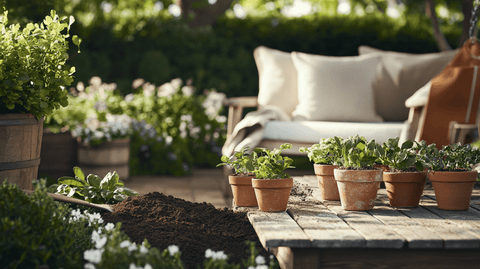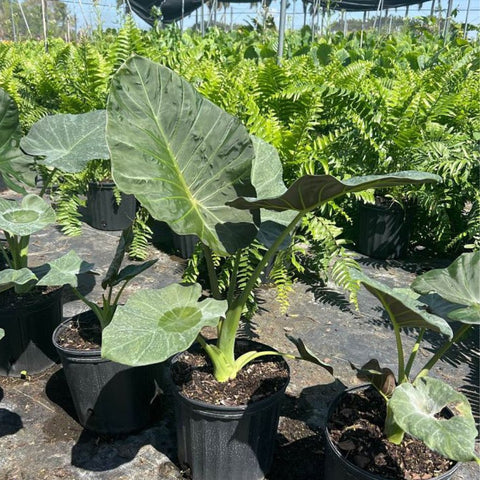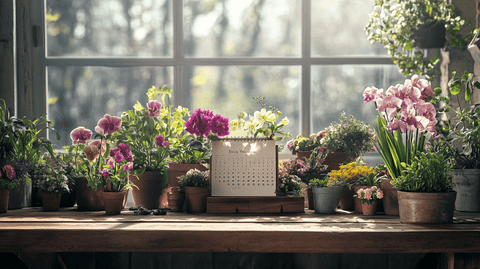Introduction
Spring heralds a time of renewal and growth. However, for avid gardeners and green thumbs, it also signals the challenge of dealing with compact soil. This seemingly benign issue can have a profound impact on plant health and growth, impeding the lush vitality we crave in our gardens. Compact soil is a barrier—not only to roots yearning to delve deeply into the earth but also to the myriad tiny creatures and nutrients that support plant life.

Tackling soil compaction is critical as the thaw of spring approaches. Without addressing this issue, plans for a thriving garden may fall flat, quite literally. Through understanding and remedying this common soil dilemma, we can ensure a nurturing environment ready for spring planting. In this comprehensive guide, we will explore what soil compaction is, its causes and effects, and different methods to fix it, with some strategic recommendations from Plantology’s diverse plant offerings to complement your rejuvenated soil.
Understanding Soil Compaction
Definition and Causes
Soil compaction occurs when soil particles are pressed together, reducing pore space. This compressed state of the soil results in restricted air, water, and nutrient movement. Imagine trying to breathe through a tightly pinched straw; this is akin to how compacted soil affects plant roots.
Several factors contribute to soil compaction:
- Heavy Machinery: Vehicles and equipment, when used repeatedly over the same land, compress the soil under their weight.
- Foot Traffic: Frequently trodden paths, be it from humans or animals, contribute to this condition.
- Rain Impact: Large raindrops can hit the soil with enough force to compact it, especially after heavy storms.
Effects of Soil Compaction
The consequences of soil compaction are numerous. For plants, compacted soil restricts root growth, leading to stunted plants. Water drainage is impeded, causing either waterlogging or drought within the same patch of ground, depending on the weather. Nutrient uptake is similarly affected, all contributing to poor plant health.

Moreover, the microenvironment suffers as well. Worms and beneficial bacteria experience difficulty in movement and habitat creation, further reducing soil fertility and aeration capabilities.
Assessing Soil Compaction in Your Garden
Signs of Compact Soil
Detecting compact soil doesn’t require specialized equipment; a few observations and simple tests will indicate the presence of compact soil:
- Poor water absorption: Notice if water remains pooled on the surface for extended periods after watering.
- Hard Soil Surface: If you find it challenging to insert a garden trowel, you may be dealing with compact soil.
- Plant health: Wilting or stunted growth despite adequate watering and sunlight may signal compaction.
Testing for Soil Compaction
- The Screwdriver Test: Try pushing a screwdriver into the soil. If it requires significant effort, compaction is present.
- Soil Core Test: Using a soil corer or a stick, take a core sample and examine the structure. Compact soil will have minimal visible pore spaces and resistance to let the coring tool penetrate.

Techniques for Fixing Soil Compaction
Mechanical Methods
Aeration
One of the most effective methods to address soil compaction is aerating the soil. Aeration involves perforating the soil with holes to allow air, water, and nutrients to penetrate deeper. Depending on your garden's size, this can be done manually with a garden fork or mechanically with an aeration machine.
Tilling
Tilling the soil is another approach, particularly useful in vegetable gardens. It breaks up compact layers but should be done sparingly to avoid excessive disturbance that may lead to compaction in the future.
Biological Methods
Use of Cover Crops
Certain cover crops like clover or radishes can minimize soil compaction. Their roots help break and loosen the soil structure while adding organic matter as they decompose.
Planting Deep-Rooted Plants
Incorporate plants with deep root systems that naturally penetrate and loosen the soil. Consider Plantology’s Agave Blue as an attractive option to assist in combating compact soil.
Amendment Addition
Introducing amendments like organic matter, compost, or gypsum helps improve soil structure:
- Organic Matter: Enhances soil aeration and microbial activity.

- Compost: Improves water retention and soil fertility.
- Gypsum: Particularly effective in clay soils, gypsum improves soil structure by breaking up particles.
Preventing Future Soil Compaction
Proper Garden Design
A well-thought-out garden layout can minimize compaction risks. Stepping stones and designated pathways limit foot traffic over planting areas. Raised garden beds not only improve drainage but also reduce compaction risks from foot traffic entirely, providing a controlled planting environment.
Rotational Planting
Regularly rotating crops and plant positioning ensures that no particular area of the garden is repeatedly stressed. By changing the plant locations annually, you prevent localized compaction and nutrient depletion, ensuring diverse ecosystem health.
Correct Watering Techniques
Opt for drip irrigation systems that deliver water directly to plant roots without excess surface runoff, which can lead to compaction. Moreover, mulch application retains moisture and creates a protective layer, further aiding in reducing soil compaction effects.
Choosing the Right Plants for Spring Planting
Recommendations for Compact-Soil-Friendly Plants
While efforts to amend soil compaction are ongoing, some plants can withstand the rigors of compact soil better than others. Consider resilient varieties such as the Adonidia Palm Single or our Aglaonema Silver Bay, which are well-suited for difficult soils.

Incorporating Diverse Plant Species
Diversity in plant species promotes a resilient garden ecosystem. By mixing deep-rooted plants with shallow-rooting varieties and choosing species with varying strengths, your garden can better withstand compaction cycles.
Conclusion
Fighting soil compaction is an essential part of preparing for a successful spring planting season. By understanding its causes, effects, and the steps needed to address this issue, you can ensure better growth conditions for your plants. At Plantology, we offer a selection of plants specifically curated to function well with amended and compact soils, making your garden planning a breeze. Check out our full range at Plantology to complement your gardening endeavors.
Don’t let compact soil impede your garden's potential growth this spring. With the right care, techniques, and plant choices, a vibrant garden is well within reach. Happy planting!
Deep Dive: Soil Compaction and Its Broader Impacts
The Environmental Aspect
Beyond the confines of our gardens, soil compaction represents a significant environmental challenge. Compacted soil is prone to increased runoff, as water is unable to effectively penetrate the surface. This runoff can result in higher erosion rates, transportation of pollutants into waterways, and reduction of groundwater recharge. As urbanization increases, with more roads and building sites contributing to hard surfaces, recognizing and mitigating soil compaction becomes crucial for sustainable development.

Impacts on Soil Ecology
The soil is more than a substrate for plants; it's a bustling metropolis of organisms, interactions, and processes. Soil compaction disrupts the balance of this ecological network. Microbial life is particularly affected, as bacteria and fungi find it difficult to access organic matter in compacted conditions. This disruption affects the decomposition process and nutrient cycling, ultimately diminishing soil fertility. Earthworms, which are vital for aerating and enriching soil, struggle to navigate compacted layers, further reducing the ecosystem's health.
Soil Compaction in Different Soil Types
Sandy Soils
Sandy soils, known for their large particle sizes and grainy texture, are generally less prone to compaction compared to clay soils due to their natural drainage capabilities. However, they can still face compaction, particularly when subjected to heavy machinery or inadequate organic matter. In sandy soils, compaction can exacerbate nutrient leaching as water washes them away quickly.
Clay Soils
Clay soils are more susceptible to compaction due to their small particle size and dense nature. These soils tend to become very hard when dry and very sticky when wet. A significant compaction level in clay soils can lead to waterlogging, as water is unable to move through the dense particles efficiently. Gypsum can be particularly beneficial here to break up the soil structure and enhance permeability.
Loamy Soils
Loamy soils contain a balanced mixture of sand, silt, and clay, offering good fertility and drainage properties. However, in areas with frequent foot traffic or mechanical pressure, even loamy soils can become compacted. Strategic aeration and the addition of organic matter can help maintain the health of loamy soils.

Case Studies: Successful Soil Compaction Management
Urban Gardening Solutions
In bustling cities, community gardens provide a retreat and source of fresh produce. However, compaction from previous land use can pose challenges. Gardeners in New York's Manhattan Borough used raised beds and potted plants in spaces previously covered by concrete, integrating vermicomposting to continually enrich the soil. The project was successful in creating lush garden spaces despite the initial compacted conditions.
Agriculture and Crop Rotation
In agricultural settings, crop rotation is an ancient yet highly effective method of mitigating soil compaction. For instance, farmers in the Midwest have alternated between planting alfalfa—a deep-rooted crop—and grains to naturally aerate the soil and reduce compaction. This approach has fostered higher crop yields and reduced the need for mechanical tilling.
Rehabilitation Projects in Construction Sites
Soil rehabilitation in construction zones is gaining traction. One project in Portland, Oregon, focused on transforming a former industrial site into a green park. By employing bio-remediation techniques involving planting native grasses that could tolerate and eventually alleviate compacted soil, the project successfully revitalized the area, enhancing both soil quality and urban biodiversity.
Innovative Tools and Technologies
Intelligent Compaction Equipment
Recent advancements have led to the development of intelligent compaction equipment that assesses and adjusts compaction levels in real-time. These machines incorporate sensors and GPS technology to map soil density across vast areas, ensuring more uniform compaction and reducing unnecessary mechanical impact on the soil.

Soil Moisture Sensors
Soil moisture sensors provide invaluable data that helps manage soil compaction by informing optimal watering schedules. In gardens, these sensors can prevent overwatering, which often leads to excess soil compaction, particularly in clay-rich soils. Automating watering systems with sensor data ensures that moisture levels remain ideal for plant health while minimizing compaction risks.
Carbon Footprint-Reducing Machines
In response to environmental concerns, manufacturers are developing machinery with reduced carbon footprints, including electric tillers and low-emission engine aerators. These tools are more sustainable alternatives for gardeners aiming to address soil compaction with minimal ecological impact.
The Role of Education and Community Involvement
Training Workshops
Educational initiatives play a key role in disseminating knowledge about soil health and compaction mitigation. Workshops hosted by local agricultural extensions or garden clubs can teach best practices in soil management. These sessions often cover practical skills such as identifying compaction, proper aeration techniques, and how to choose the appropriate plants for different soil conditions.
Community Gardening Programs
Community gardening programs offer a collaborative approach to addressing soil issues. By pooling resources and knowledge, participants can tackle large-scale compaction problems that would be challenging individually. These programs often lead to the creation of shared composting sites and the cultivation of native plants that naturally improve soil structure.

Online Platforms and Resources
The internet serves as a rich repository of information and support for those dealing with compact soil. Websites dedicated to horticulture, agriculture, and environmental conservation provide guides, forums, and case studies. Additionally, social media groups focused on sustainable gardening practices offer a platform for problem-solving and peer consultation.
A Glimpse into the Future: Sustainable Practices
Embracing Permaculture Principles
Permaculture offers a holistic and sustainable approach to land management that inherently addresses compaction. By designing gardens that mimic natural ecosystems, permaculture reduces the need for heavy machinery and excessive human intervention. Techniques such as using swales for water management and creating polyculture plantings can significantly reduce soil compaction and enhance biodiversity.
Carbon Sequestration Practices
Regenerative agriculture, which focuses on improving soil health and sequestering carbon, provides a framework for tackling soil compaction. Techniques such as no-till farming and cover cropping increase organic matter, improving soil structure and reducing compaction. These methods not only enhance productivity but also have the potential to combat climate change by storing carbon in healthy soils.
The Rise of Eco-Friendly Products
Eco-friendly solutions are emerging to combat soil compaction while being conscious of the environment. Products such as biodegradable mulches and organic soil conditioners support soil health and growth without detrimental additives. As advances continue, these products will become integral to sustainable gardening and farming practices.

Final Thoughts: A Path to Thriving Gardens
Addressing soil compaction is not merely a technical challenge; it is a pursuit of creating harmony between humans and the earth. By adopting innovative solutions, collaborating with local communities, and adhering to sustainable practices, we can transform compacted soils into vibrant ecosystems. As we engage in this journey, the possibilities for garden and ecological restoration are vast and promising.
At Plantology, we are committed to supporting gardeners in their endeavors to foster healthy plants and sustainable landscapes. Our wide selection of plants, educational resources, and community initiatives are designed to assist you in overcoming soil compaction and achieving a flourishing garden. Explore our offerings by visiting Plantology and embark on your journey to a vibrant, thriving garden.






























Comments (0)
There are no comments for this article. Be the first one to leave a message!